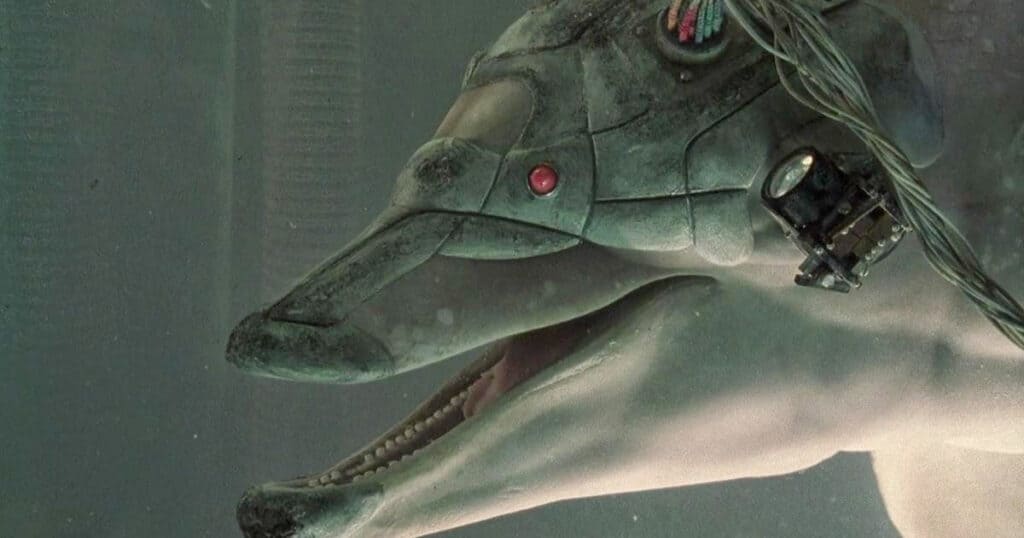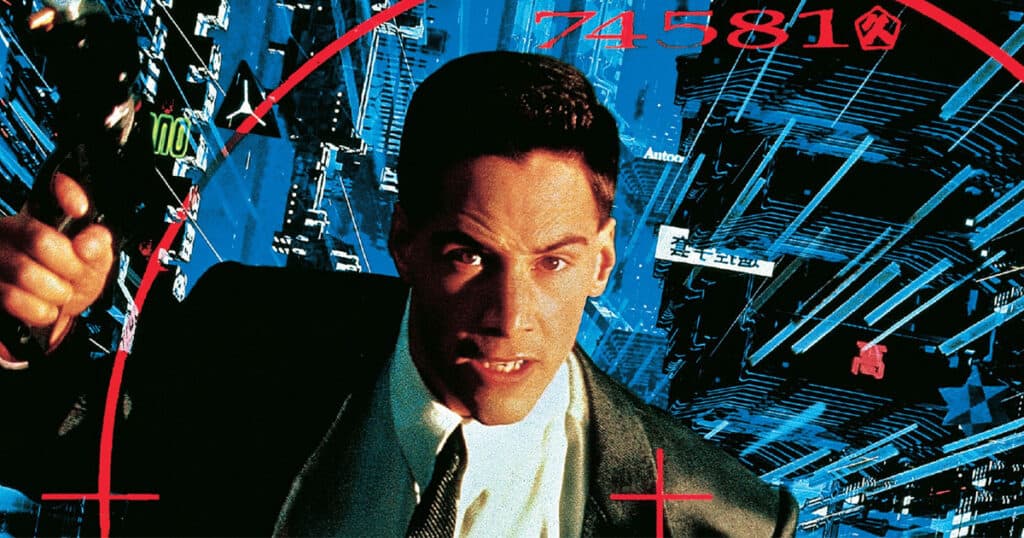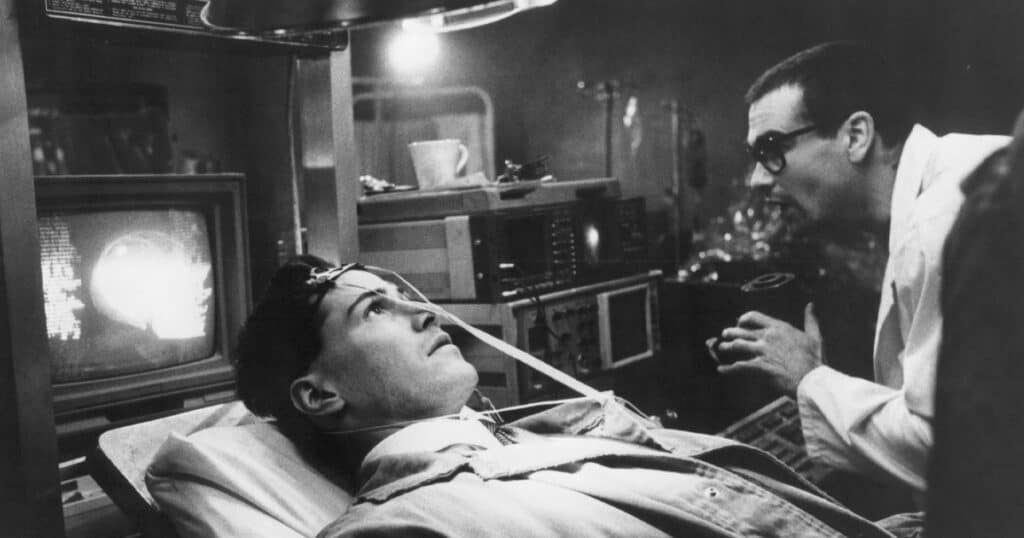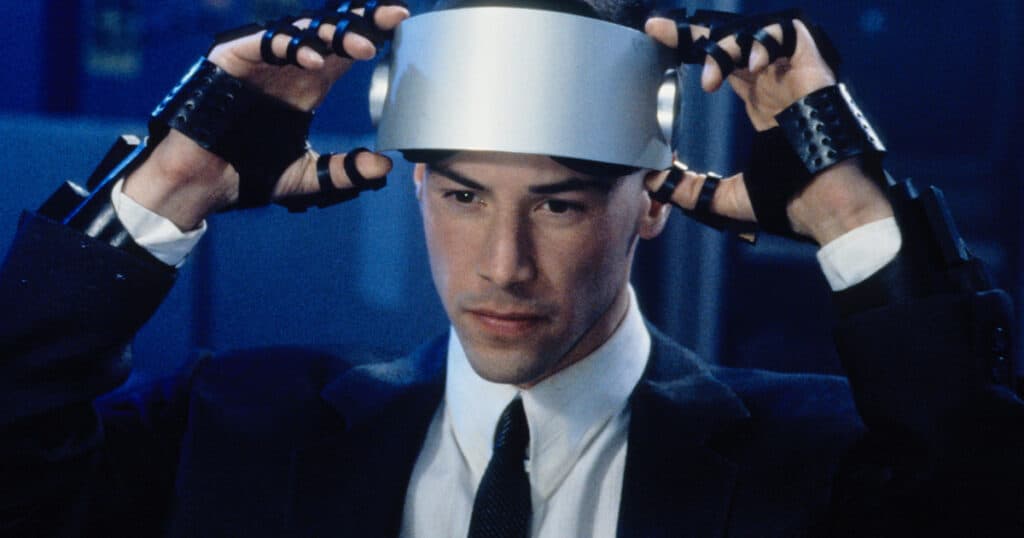Entertainment - Media News Watch originally published at Entertainment - Media News Watch
The cyberpunk genre is perhaps now more popular and relevant than ever, and the same can be said for actor Keanu Reeves. Together they would prove to be a powerful pairing with the sci-fi masterpiece The Matrix and the recent hit videogame Cyberpunk 2077.
However, that was not the case in 1995, when Johnny Mnemonic was released to confounded and indifferent audiences. How did the combined efforts of a newly minted A-list star, a noted visionary artist, and a pioneer in cyberpunk fiction result in a target of ridicule and a box office disappointment?
Jack in and fill your head with WTF Happened to this Movie!
The cyberpunk genre of science fiction is characterized by the theme of “high technology and low life”. It usually involves dystopian future societies, advanced science, and technology, body enhancements and dominant corporations. Its influences and origins can be traced to authors such as Harlan Ellison and Michael Moorcock. Ballard, and of course Philip K. Dick, whose stories have been adapted into movies like Total Recall, Minority Report, and what many see as the quintessential cyberpunk movie, Blade Runner.
But William Gibson is probably the name most commonly associated with cyberpunk. Gibson is credited for coining the term “cyberspace,” long before the world became connected by fiber-optic or wireless networks. His award-winning 1984 book Neuromancer has inspired a generation. Longo reached out to Gibson, only to find that Gibson was familiar with his work. The mutual admiration quickly developed into a friendship.
Longo was eager to direct feature-length films after directing music videos for bands such as New Order, REM, Megadeth and “Arena Brains”, which featured Ray Liotta and Steve Buscemi. He had also directed short films with Ray Liotta and Eric Bogosian. The Arena Brains producer was willing to finance a feature for under $2 million, and Longo decided on adapting Gibson’s early short story Johnny Mnemonic, with the author handing Longo the film rights in exchange for an original drawing.
Longo’s initial plan for
Johnny Mnemonic was an avant garde black-and-white film noir with the vibe of material like Jean Luc Godard’s Alphaville and the Orson Welles classic Touch of Evil, but by 1990 that version of the project had collapsed. In the subsequent search for alternate funding, Longo and Gibson swiftly discovered that film companies didn’t have much interest in trivial productions for $1.5 million, but only larger budgets of at least ten times that figure.Around that time, Longo had also entered the orbit of super-producer Joel Silver, who learned of the artist’s directing desires. Silver was interested in producing J
ohnny Mnemonic, and got the project set up with independent studio Carolco Pictures, and Longo was given a sort of audition by directing an episode of the Silver-produced HBO anthology series “Tales from the Crypt.” Carolco hired William Gibson himself to perform rewrites for what was then anticipated to be a $15 million production.One of the early challenges had been expanding Gibson’s original 1981 story, which was a mere 22 pages, to a satisfying feature film length. The story’s basic elements would remain: a courier with a cranial drive containing encrypted data, a double-crossing assassin from the Yakuza, a cyborg Dolphin, and an outcast group known as Lo-Teks. Gibson borrowed liberally, and introduced new plots and “cinematic pace” to stretch the story. The data in Johnny’s overloaded mind storage is now both a ticking time bomb as well as the cure for a global pandemic known as Nerve Attenuation Syndrome. This mysterious disease is also known as “black shakes” and is the result of constant exposure the technology that has become a global addiction. PharmaKom, the corporate owner who owns the sensitive data, wants it back so they can maximize their profits. They dispatch assassins literally to collect Johnny’s skull. The Neuromancer film rights were already owned by another studio. This meant that the character of Molly Millions, a razor-fingered mercenary with a lot of skill, was not available for Gibson’s adaptation of Johnny Mnemonic. Jane, a desperate bodyguard wannabe who suffers from “black shakes”, would take her place. A former Carolco executive wanted to make Johnny Mnemonic, and pitched it to different studios. But to no avail. The project was eventually supported by the Canadian company Alliance… as well as around 20 different international investors. Sony’s Tristar Pictures would distribute the film in America. The studio would make constant revisions and creative demands that were frustrating for the writer and the director. German actor Udo KIER was cast as Johnny’s duplicitous handler Ralfi. The backers insisted on Dolph Lundgren, and Longo and Gibson were left confused about how to use the hulking Swede. Ultimately they took the script’s minor character of Karl the Street Preacher and reinvented him from heavy-metal biker into an imposing cyborg Christ figure with rambling diatribes and a crucifix knife.
Hardcore punk rock frontman Henry Rollins, who admitted he had no interest in science fiction but was a fan of Longo’s art, joined as flesh mechanic Spider. Ice-T, who was then best known for her appearances on Beverly Hills 90210 as the anarchist leader J-Bone and Dina Meyer as the unstable enforcer Jane, completed the main cast. But before production began, Val Kilmer quit the lead role due to the usual “creative differences”. Longo stated that Val Kilmer wanted to make a completely different movie from what he did. He also had Batman on the back burner. Reeves, Gibson and the rest of the cast were Canadians. The decision was made to shoot in Toronto so that they could take advantage tax incentives. The most expensive movie in Canadian history at the time was
JohnnyMnemonic
, with a budget of $26 million. For Longo, this location meant a further compromise because it required that a certain percentage also be Canadian. Longo could no longer use his intended director of photography Michael Chapman, whose credits included
The Lost Boys, Taxi Driver
and
Raging
Bull

. He would instead have to choose from a very small list of Canadian cinematographers. He ended up with a DP who’s biggest credit was the Weekend At Bernie’s. The entire production process was expected to take several months. Longo moved to Toronto with his wife Barbara Sukowa and their two children. Barbara Sukowa would also be playing an important A.I. The entire production process was expected to last several months, so Longo moved his family to Toronto with his two children and his pregnant wife, actress Barbara Sukowa, who would also play an important A.I. Gibson described the winter as the worst in Canadian history. Longo was also working in this harsh, nightmare environment.
The opening street sequence was shot in subzero temperatures. Longo was apprehensive at first about the situation he had put himself in. He described directing as being “like riding a bicycle without handlebars.” Although he had a vision of how the film should look and could imagine the characters, he felt uncomfortable giving instructions to experienced actors. Reeves portrayed Johnny as robotic, but he trusted Longo. He also supported him. Longo later discovered that shortly after filming had started, the producers seriously considered firing him and had actually promised the job to second unit director and stunt coordinator Vic Armstrong.One area where Longo was confident was art direction. He wanted to emphasize what he called casual technology and described his vision of “BLADE RANNER if it were directed by Fellini”. Nilo Rodis was the production designer who worked on Poltergeist, Empire Strikes Back and Longo’s sketches. Together they brought his ideas and sketches to life. Together, they had to create future Newark, New Jersey, and Beijing, China. But the movie’s star was Heaven, the enormous HQ of the Lo-Tek Guerrillas and their cyborg Dolphin colleague. The massive construction, suspended 15 feet over the floor of a Toronto storage warehouse, cost more than $3.5 million. Gibson said the first time he stepped on the massive set and witnessed his imagination made real, he was rendered speechless for hours.Because Longo and Gibson were both making their feature debut, they were viewed as unpredictable by the producers and financiers. Longo said, “Going to Hollywood from the art world is like trying transfer to a school that won’t accept your credits.” The script was a constant source of disagreement, even as the cameras rolled. Longo fought with executives and his DP over artistic decisions, from the early overhead scene of the bathroom to the Gone with the Wind crane shot of Spider’s NAS trauma centre. Even for something seemingly innocuous like a tilted camera angle, the director had to adjust it himself during lunch. He would then have to call action immediately after the break ended before the camera could be changed. Longo refused to shoot a final Terminator resurrection of Lundgren’s crispy cyborg. Instead, he shot a joke that appeased executives. – The creative struggle to overcome cliches, which Longo called “making arts by committee”, was compounded with the frantic filming schedule and the exhaustion that comes from being a new father. Johnny’s rant under the Lo-Tek Bridge was born out of Longo’s frustrations. Gibson added the rant the night before, at the director’s request. He felt that the protagonist should also be agitated by the situation. It became one of the most memorable scenes in the movie. Longo also began stress eating during production and gained more than 30 pounds. But the star went the other way. Reeves, who was largely shooting the movie in order, began severely limiting the calories he ate so that Johnny would appear physically sick over the course the movie due to the data corruption within his head. A reshoot done later to add a new opening scene proved fortuitous as the actor had returned to a healthy physique, further highlighting the contrast to Johnny’s final slender frame.Getting through principal photography was not nearly the end of the agony for Longo and Gibson. As
Johnny Mnemonic
had barely entered post-production, Keanu Reeves suddenly became a major movie star when
Speed
hit theaters and reached blockbuster status with breathtaking velocity. Tristar, with Reeves suddenly catapulted to the A-list and a gap in their schedule, thought they had a potential blockbuster. The production of their big planned summer release – the Julia Roberts Jekyll-and-Hyde-thriller [J-Bone: “Just garbage. Get that outta here!”]Mary Reilly

– was a complete failure and had to be delayed. Johnny Mnemonic[“I want room service! I want the club sandwich! The cold Mexican beer!”] was originally scheduled for a smaller release in February, but it would now be moved to the more lucrative Memorial Day Weekend. Even after all the creative concessions Gibson & Longo made, the material that they wrote & filmed was about change dramatically when the studio took over the edit. Ron Sanders, David Cronenberg’s long-time editor, was dragged into the recycling bin for his versions. The studio wanted more stunts and less dialogue, so they cut around 30 minutes from the narrative cohesion. Reeves was given a more likeable nihilistic persona by removing the edges of his character. Gibson’s trademark cyberpunk and slang were simplified or trimmed to reach a wider audience, which one executive called “the Gibson-impaired.” The studio also cut much of Lundgren’s unhinged sermon, including his bombastic message about posthumanity. The Japanese release of the finished score by Mychael Dana was replaced by Brad Fiedel’s new synth-styled music. The executives even considered changing the title of the film to something simple like Johnny Gets His Gun. The studio was determined to make a hit. Sony’s hype-machine was a powerful marketing tool that pushed the movie forward despite all the costs associated with the alterations. This included computer sequences created by Sony’s digital effect division. Millions of dollars were invested in a CD-ROM with full-motion videos featuring actors who were not the stars of the original movie. In an attempt to capitalize on the explosive growth in the internet, the new technology division of the company created a promotional online treasure hunt with cash and prizes. William Gibson, a reclusive author, was persuaded into awkward online Q&A sessions. Executives simplistically assumed the Internet would provide “turbo-charged word of mouth.” And Speed’s now-bankable hero Keanu Reeves was at center of the movie’s advertising.
Ultimately none of it mattered. [Johnny shirtless in the hotel bed]Johnny Mnemonic
hit North American theaters in May 1995. Positioned against new releases Casper and Braveheart along with holdovers
Die Hard with a Vengeance and Crimson Tide, Johnny didn’t stand much of a chance, opening in sixth place with $7.4 million and ending with a domestic total of $19 million. While moviegoers were left confused or neutral, critics were not as kind. They called the movie “high-tech garbage”, “derivative”, shabby, and perhaps more expectedly, “Johnny moronic.” Gibson described the theatrical version as “a really extreme instance of not being the Director’s Cut.” He called their original vision “an ironic tale of the information age,” that was also meant to be “a broadly comedic homage to all of the good bits of bad science-fiction films.” He added, “The film released bears almost zero resemblance with the film we shot.” Imagine David Lynch’s Blue Velve
t being recut by a distributor to make it more accessible and mainstream.
Longo described the studio decision makers as “complete idiots,” and called the whole process “torturous,” among other adjectives such as unsettling, corrupt, and devastating. Unsurprisingly, he has not directed another feature since, and claimed the experience gave him PTSD that caused creative and financial difficulties in returning to the art world he had temporarily departed.
Despite all that, Longo described his collaboration with Gibson and Reeves as “very rich” and they still remain friends, recently reuniting virtually to discuss Longo’s black-and-white update of the movie. Even after the trauma, Longo decided 25 years later to revisit JohnnyMnemonic, first ripping and converting a Blu-Ray to black-and white as he originally envisioned. Sony eventually provided Longo with high-resolution footage that he and a colorist graded into black-and white. Festival screenings were held in 2021, and the film was released on Blu-Ray, iTunes and Criterion Channel. While Longo says that the movie is only 60% of what he wanted, the black and white version brings him closer to the aesthetic he was aiming for: a $1 million art flick with grunge, attitude, and computer graphic effects that are stylized and not dated. He has no plans to revisit the movie further, so while the extended Japanese cut can be found on various foreign DVD releases, a legitimate director’s cut of Johnny Mnemonic will likely remain a cyber fantasy.William Gibson’s influence can still be found in countless movies and shows, but besides Johnny Mnemonic, only his stories New Rose Hotel and The Peripheral have actually been adapted, leaving the iconic NEUROMANCER as yet unrealized in live-action.According to the filmmakers, Johnny Mnemonic did eventually turn a profit thanks to international and home video releases, but the common perception is that the movie was a bomb and something of a punchline. But is it justified? The “futuristic” 320 gigabyte storage capacity may seem quaint now, but technology obsession, data significance, class disparity, information warfare, and profiteering megacorporations are very much part of modern life. Sure, the “futuristic” 320 gigabyte storage capacity now seems quaint, but technology obsession, data significance, class disparity, information warfare and profiteering megacorporations are very much part of modern life.
1995 was a big year for movies with elements of cyberpunk and dangerous tech , but few had the compelling world-building, oddball cast, creative pedigree and longevity of Johnny Mnemonic
.

Entertainment - Media News Watch originally published at Entertainment - Media News Watch



